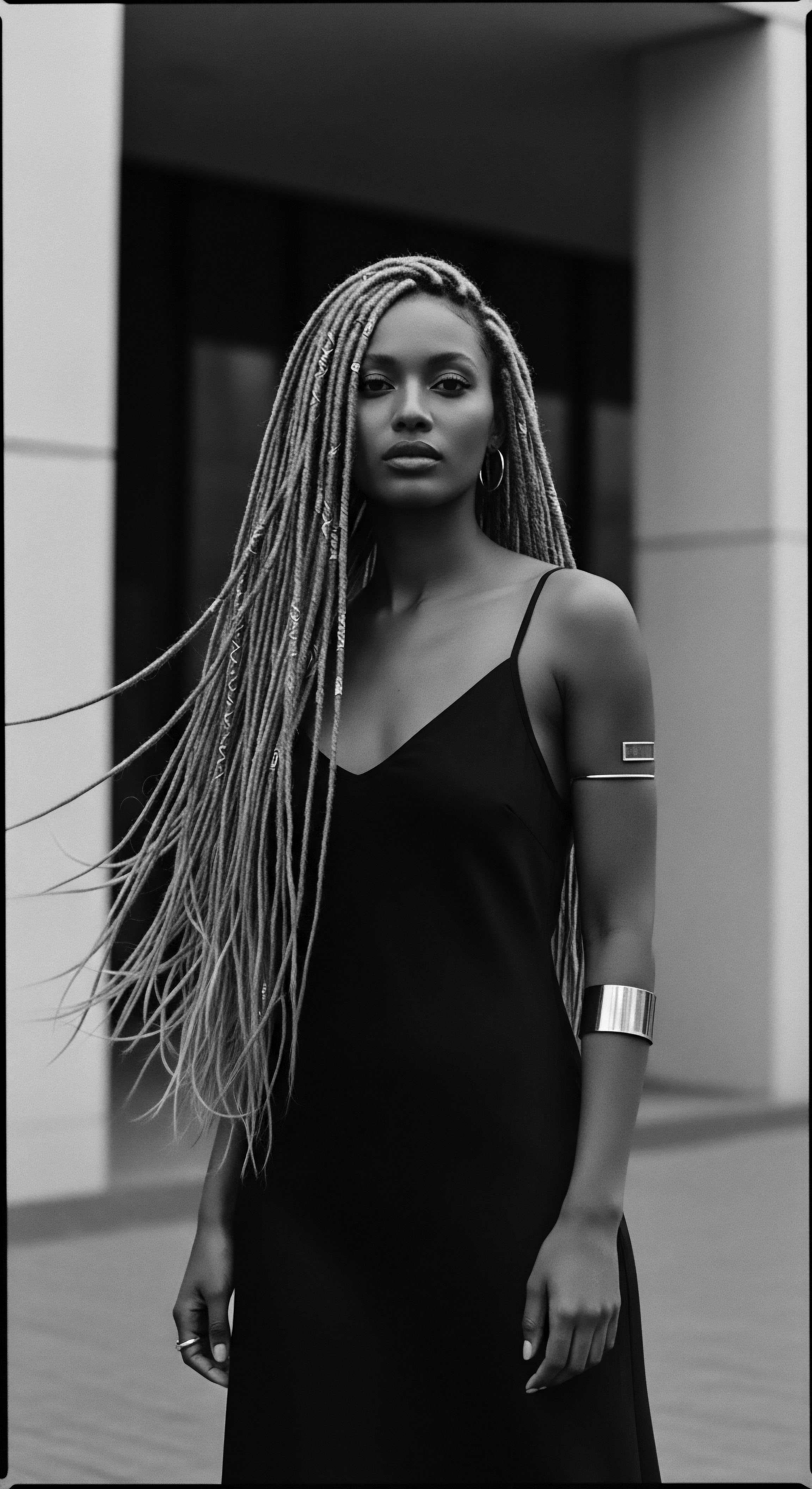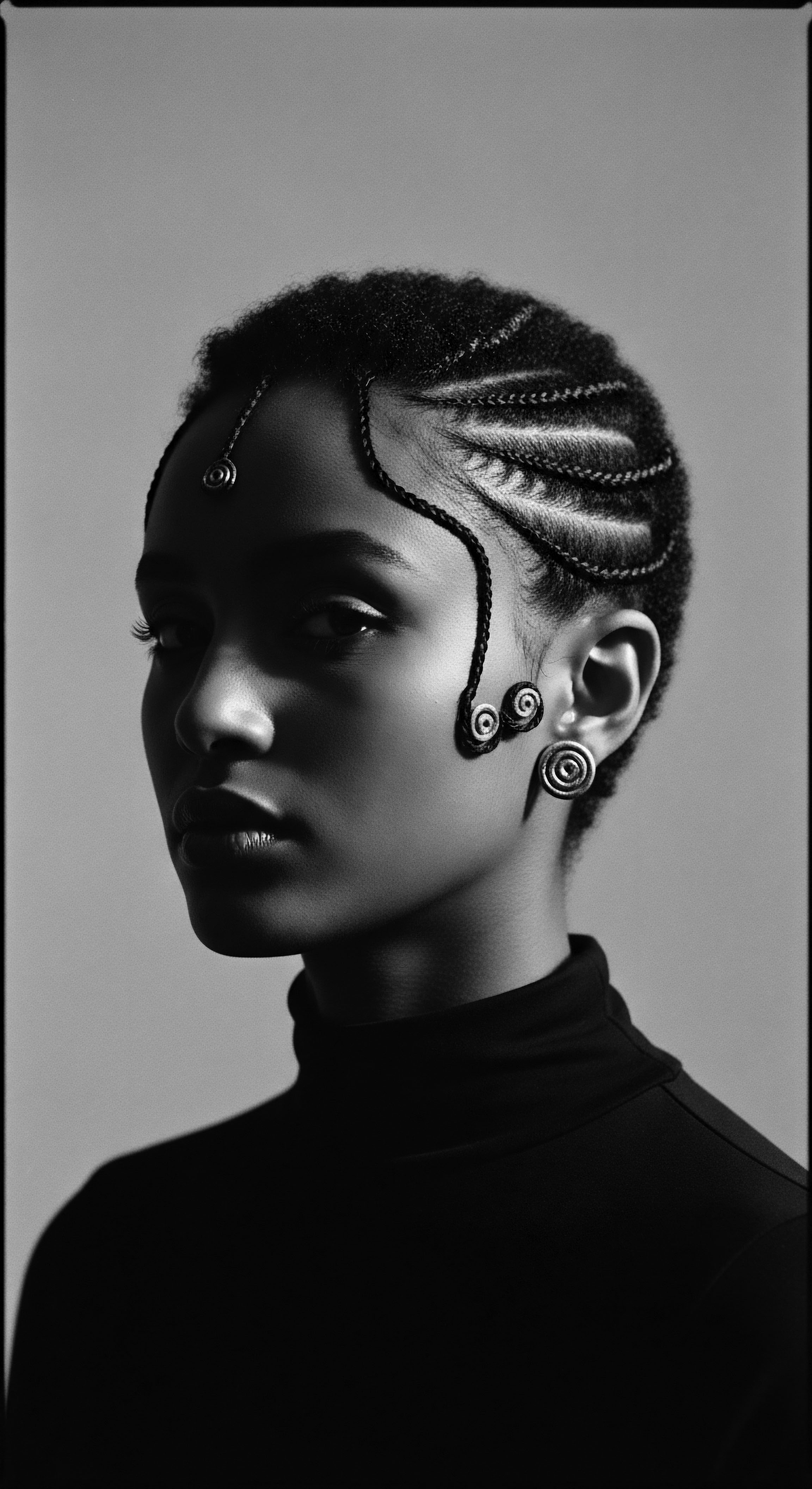
Fundamentals
The story of African Black Soap, often spoken of in hushed tones of reverence across ancestral lands, commences not merely as a cleansing agent but as a profound expression of communal ingenuity and a tangible link to the earth’s benevolent offerings. Its fundamental designation is that of a natural cleanser, born from the wisdom of West African communities, particularly the Yoruba People of Nigeria and the Akan People of Ghana, where its creation has been a cherished legacy, passed down through generations of women. This is not a product manufactured in sterile laboratories; instead, it is a living testament to indigenous ethnobotanical knowledge, a carefully crafted substance that honors the raw, potent gifts of the African landscape.
The earliest understandings of this soap centered on its elemental biology. Its making relies on the transformation of specific plant matter, rendering its true essence. The primary components, gathered with intentionality, include the ash derived from sun-dried and roasted plantain skins, cocoa pods, shea tree bark, and palm tree leaves. These seemingly humble elements, when subjected to traditional processes, undergo a metamorphosis, yielding a potent alkali essential for saponification—the very heart of soap formation.
This process, devoid of synthetic additives, ensures the final product retains the inherent properties of its botanical sources. The initial purpose was deeply practical ❉ to cleanse the body, skin, and hair, yet this utilitarian aspect was always intertwined with a deeper cultural resonance, a connection to the rhythms of the earth and the communal spirit.
African Black Soap stands as a living archive of ancestral wisdom, transforming nature’s bounty into a cleansing ritual.

Echoes from the Source ❉ The Raw Materials
The selection of ingredients for African Black Soap speaks volumes about a nuanced comprehension of the natural world. Each component contributes uniquely to the soap’s character and efficacy, especially for textured hair.
- Plantain Skins ❉ These provide a significant source of potassium-rich ash, a key alkali in the soap-making process. They contribute to the soap’s deep cleansing properties and its gentle exfoliation.
- Cocoa Pods ❉ After drying and roasting, these yield ash also rich in potash, which aids in saponification and contributes to the soap’s characteristic dark hue. Cocoa pod ash is recognized for its cleansing abilities and natural exfoliation.
- Shea Tree Bark ❉ A less common but historically present ingredient, its ash adds to the alkaline base, while the broader use of shea butter, derived from the nuts of the shea tree, is a central moisturizing component.
- Palm Kernel Oil ❉ Extracted from the seeds of the palm tree, this oil contributes to the soap’s lathering qualities and its moisturizing properties, essential for maintaining hair’s moisture balance.
The deliberate combination of these elements underscores a profound ancestral understanding of how to balance cleansing power with nourishing attributes, a balance particularly crucial for the delicate nature of textured hair. The designation of this soap as ‘living’ derives from its organic origins and the preservation of its natural vitality, a quality that distinguishes it from many modern, industrially produced cleansers.

The Alchemical Process ❉ A Communal Creation
The creation of African Black Soap is not a solitary endeavor but a communal practice, often orchestrated by women, serving as a testament to shared knowledge and collective purpose. This intricate process involves several stages, each requiring patience and expertise:
- Ash Preparation ❉ Plantain skins, cocoa pods, and other plant matter are sun-dried, then roasted in clay ovens until they reduce to ash. This ash provides the natural lye necessary for the chemical reaction.
- Oil Extraction ❉ Various natural oils, including palm kernel oil and shea butter, are extracted through traditional methods. Shea butter, for instance, has been a staple in West African households for over 700 years, used for both cooking and as a moisturizing salve for skin and hair.
- Saponification ❉ The prepared ash is then mixed with water to create a lye solution, which is combined with the oils and heated. This mixture is stirred continuously, sometimes for hours or even days, allowing the fats and the alkali to react and transform into soap.
- Curing ❉ Once the mixture solidifies into a soft, malleable mass, it is often left to cure for several weeks, allowing it to harden and further develop its properties.
This traditional method, largely unchanged for centuries, represents a sophisticated indigenous chemical process, yielding a product that embodies both practical utility and deep cultural meaning. The creation of African Black Soap is a tangible connection to generations past, an echo of ancestral hands shaping the future of care.

Intermediate
As our comprehension of African Black Soap deepens, we recognize its significance extends beyond its foundational composition and creation. The intermediate delineation of African Black Soap centers on how its heritage practices have been meticulously passed down and thoughtfully adapted, particularly in the realm of textured hair care. This substance, known by names such as “Dudu Osun” among the Yoruba and “Alata Samina” by the Akan people, carries the weight of centuries of wisdom, continually reinterpreted to meet the evolving needs of Black and mixed-race hair experiences. It represents a continuity of care, a tender thread connecting ancestral rituals to contemporary self-expression.
The practical application of African Black Soap for textured hair types is where its meaning truly unfolds for many. Its unique formulation, rich in natural saponifiers and nourishing oils, makes it a valuable tool for addressing common textured hair concerns. It provides a thorough cleansing for the scalp and hair strands, effectively removing product buildup and excess oil without stripping away essential moisture, a balance often difficult to achieve with conventional cleansers.
This gentle yet effective cleansing promotes a healthy scalp environment, a cornerstone for resilient hair growth and overall hair vitality. The consistent use of this traditional soap for scalp health is a practice rooted in generations of observation and lived experience, now affirmed by contemporary understanding of scalp microbiome balance.
African Black Soap is a generational conduit, transmitting traditional care practices that honor and nourish textured hair.

The Tender Thread ❉ Traditional Hair Care Rituals
Within African communities, hair care is rarely a solitary, utilitarian act; it is often a communal ritual, a moment of bonding, storytelling, and the transmission of knowledge. The use of African Black Soap is deeply embedded in these practices.
- Scalp Cleansing Ceremonies ❉ Historically, and continuing in many communities, the soap is worked into a gentle lather and massaged into the scalp, not just to clean, but to stimulate circulation and prepare the scalp for subsequent nourishing treatments. This ritualistic approach underscores the belief that hair health begins at the root.
- Preparation for Styling ❉ After cleansing with African Black Soap, hair is often more pliable and receptive to traditional styling methods like braiding, twisting, and threading, which are themselves ancient forms of hair art and communication. These styles were not merely aesthetic choices; they conveyed messages about age, marital status, tribal affiliation, and social standing.
- Post-Cleansing Nourishment ❉ Following the soap’s use, traditional emollients such as Shea Butter or various plant oils would be applied to seal in moisture and protect the hair. This multi-step approach, beginning with the deep cleansing of African Black Soap, reflects a holistic understanding of hair care that has sustained textured hair for centuries.
This continuous passing of practices, from elder to youth, serves as a powerful form of cultural preservation. It is through these shared moments of care that the living legacy of African Black Soap is sustained, its significance transcending mere product utility to become a vessel of cultural continuity.

Community and Adaptation ❉ A Diasporic Resonance
The narrative of African Black Soap is not static; it has traveled across continents, adapting and finding new expressions within the African diaspora. Its significance has evolved, yet its core identity as a natural, heritage-rooted cleanser remains.
The forced displacement of the transatlantic slave trade severely disrupted many African cultural practices, including hair care rituals. Enslaved Africans were often compelled to shave their heads, a deliberate act of dehumanization and cultural erasure. Yet, the resilience of ancestral knowledge persisted.
While the specific ingredients for African Black Soap might not have always been readily available in new lands, the memory of its efficacy and the principles of natural, plant-based cleansing continued to influence hair care practices. This led to adaptations, where available local ingredients were used to recreate similar cleansing agents, a testament to the enduring human spirit and the power of inherited wisdom.
Today, African Black Soap has found renewed prominence in the global natural hair movement. Its widespread recognition is a contemporary manifestation of its timeless value. The soap is a symbol of reclaiming and celebrating textured hair heritage, a rejection of Eurocentric beauty standards that historically marginalized natural Black hair. This renewed interest highlights how traditional knowledge, once localized, can achieve global recognition, serving as a beacon for those seeking authentic, effective, and culturally resonant hair care solutions.
The journey of African Black Soap, from communal West African villages to diverse global communities, illustrates a dynamic adaptation. It is a powerful example of how heritage practices, when grounded in genuine efficacy and cultural meaning, possess an inherent strength that allows them to persist, transform, and continually offer value across different eras and geographies.

Academic
The advanced explication of African Black Soap reveals its profound meaning as a complex interplay of ethnobotanical science, cultural semiotics, and socio-economic dynamics, particularly within the expansive context of textured hair, Black hair, and mixed-race hair heritage. This is not simply a cleansing agent; it is a cultural artifact, a biochemical marvel, and a symbol of resilience, continually shaping and being shaped by the experiences of communities across the globe. Its significance transcends superficial utility, delving into the very fabric of identity and ancestral connection.
The anthropological perspective unveils African Black Soap as a deeply embedded element within indigenous African lifeways. Hair, in many pre-colonial African societies, was considered the most elevated part of the body, a conduit for spiritual connection and a visual marker of identity. Hairstyles and hair care rituals communicated a person’s age, marital status, social rank, and even their tribal affiliation. The meticulous attention paid to hair, often involving cleansers like African Black Soap, was therefore not merely about aesthetics but about spiritual well-being and communal belonging.
This soap, derived from the earth’s bounty, participated in rituals that reinforced social structures and cosmological beliefs. The very act of its creation, often a collective endeavor among women, served as a communal bond, transmitting knowledge and strengthening social cohesion.
African Black Soap embodies a rich confluence of traditional knowledge, scientific efficacy, and cultural symbolism for textured hair heritage.

Ethnobotanical Science and Biochemical Profile
From a scientific vantage point, African Black Soap represents a sophisticated understanding of plant chemistry, long before modern laboratories formalized such knowledge. The efficacy of African Black Soap for textured hair and scalp health can be attributed to its unique biochemical profile, derived directly from its natural ingredients.
- Alkaline Properties ❉ The ash components, rich in potassium hydroxide (potash), provide the necessary alkalinity for saponification, transforming oils into soap. This natural alkalinity, while requiring careful formulation in traditional making, aids in deep cleansing and removal of impurities from the hair and scalp.
- Phytochemical Richness ❉ Ingredients like plantain skins and cocoa pods contain a spectrum of phytochemicals, including antioxidants and vitamins (A and E), which offer protective and nourishing benefits to the scalp and hair follicles. These compounds contribute to the soap’s ability to soothe scalp irritation and potentially address conditions like dandruff.
- Emollient Oils ❉ The inclusion of shea butter, palm kernel oil, and coconut oil provides significant moisturizing and conditioning properties. These natural lipids help to prevent the stripping of moisture, a critical concern for textured hair, which is inherently prone to dryness due to its coil structure.
A survey conducted by Agyepong et al. (2017) on attitudes and practices of Black Soap users revealed widespread satisfaction, with 70% of participants using it for overall skin care and a remarkable 91% (51% very satisfied, 40% somewhat satisfied) reporting satisfaction with its effects on various dermatologic conditions, including acne and dark spots. While this study primarily focused on skin, it underscores the traditional belief in the soap’s efficacy, which extends to scalp health and, by extension, hair well-being. This quantitative validation lends credence to the centuries of anecdotal evidence and traditional wisdom surrounding African Black Soap.

Historical Evolution and Sociological Implications
The historical trajectory of African Black Soap reflects broader currents of cultural exchange, adaptation, and even resistance. Its origins among the Yoruba and Akan peoples, with its names like “Ose Dudu” and “Alata Samina,” point to deep indigenous roots. Accounts from the 17th century indicate its value in trade, with the Portuguese recognizing its effectiveness, though they refrained from introducing it to Europe to protect their own soap industries. This early recognition of its quality speaks to its inherent value beyond its immediate cultural context.
The diaspora experience profoundly reshaped the relationship between Black people and their hair. During the era of enslavement, the forced shaving of heads was a deliberate act of cultural violence, designed to sever connections to ancestral identity. In the face of such oppression, the care of hair, even with improvised materials, became an act of quiet defiance and cultural preservation. The continued practice of hair care, often passed down in hushed tones, served as a means of retaining a piece of self and heritage amidst dehumanization.
In contemporary times, the global market’s engagement with African Black Soap presents both opportunities and challenges. On one hand, it offers economic avenues for the women-led cooperatives in West Africa who continue to handcraft this soap using traditional methods, providing a pathway for fair trade and community development. On the other hand, the commercialization also raises questions of cultural ownership and the potential for appropriation, necessitating a careful consideration of ethical sourcing and equitable partnerships that genuinely honor the communities that originated and preserved this heritage. The reclamation of African beauty standards, including the celebration of natural textured hair, is a powerful movement that sees African Black Soap not just as a product, but as a tangible connection to a proud, resilient past.

Long-Term Consequences and Future Trajectories
The ongoing recognition of African Black Soap holds significant long-term consequences for textured hair heritage and global beauty practices. From a corporate perspective, understanding its deep cultural meaning and scientific benefits positions it as a product with intrinsic value, rather than a fleeting trend. Investment in ethical supply chains and partnerships with traditional producers ensures the sustainability of both the product and the ancestral knowledge systems that underpin it. This approach respects the origins of the soap, ensuring that the communities who have preserved its making for centuries benefit equitably from its global reach.
For individuals with textured hair, particularly those of Black and mixed-race heritage, African Black Soap represents more than just a cleansing option; it is a symbol of self-acceptance and a connection to a rich lineage of care. Its use becomes an affirmation of identity, a deliberate choice to align with ancestral wisdom and natural well-being. The soap’s consistent application for hair health, from soothing dry scalps to promoting healthy growth, reinforces a heritage of self-care that predates and stands apart from dominant beauty narratives. As research continues to validate the benefits of its natural components, African Black Soap remains a powerful reminder that ancient practices often hold the keys to enduring wellness.

Reflection on the Heritage of African Black Soap
The story of African Black Soap, as etched into Roothea’s living library, is a profound meditation on the enduring spirit of textured hair heritage. It is a testament to the ingenuity of ancestral hands, a silent song sung through generations of care. This remarkable substance is more than a simple cleanser; it serves as a conduit to ancient wisdom, connecting us to the earth’s rhythms and the communal bonds that once shaped daily life. Its very existence affirms the inherent beauty and resilience of Black and mixed-race hair, a legacy that has persisted through epochs of challenge and change.
As we reflect on its journey from the elemental biology of West African flora to its place in global wellness, we perceive a continuous dialogue between past, present, and future. The whispers of traditional rituals, the tender application of shea butter, and the shared moments of hair care within families all echo in every use of this soap. It stands as a vibrant symbol of self-acceptance, a tangible link to a heritage that celebrates natural texture and the deep-seated wisdom of our forebears. The Soul of a Strand finds its voice in African Black Soap, reminding us that true beauty is deeply rooted in identity, history, and the profound connection to our origins.

References
- Agyepong, M. A. et al. (2017). Discovering Black Soap ❉ A Survey on the Attitudes and Practices of Black Soap Users. Journal of Clinical and Aesthetic Dermatology, 10(7), 23–27.
- Beckwith, C. & Fisher, A. (1999). African Ceremonies. Harry N. Abrams.
- Byrd, A. D. & Tharps, L. D. (2001). Hair Story ❉ Untangling the Roots of Black Hair in America. St. Martin’s Press.
- Etim, F. (2019). Ontology of African Ritual. Advances in Applied Sociology, 9, 1-14.
- Omotoso, S. A. (2018). Gender and Hair Politics ❉ An African Philosophical Analysis. Journal of Pan African Studies.
